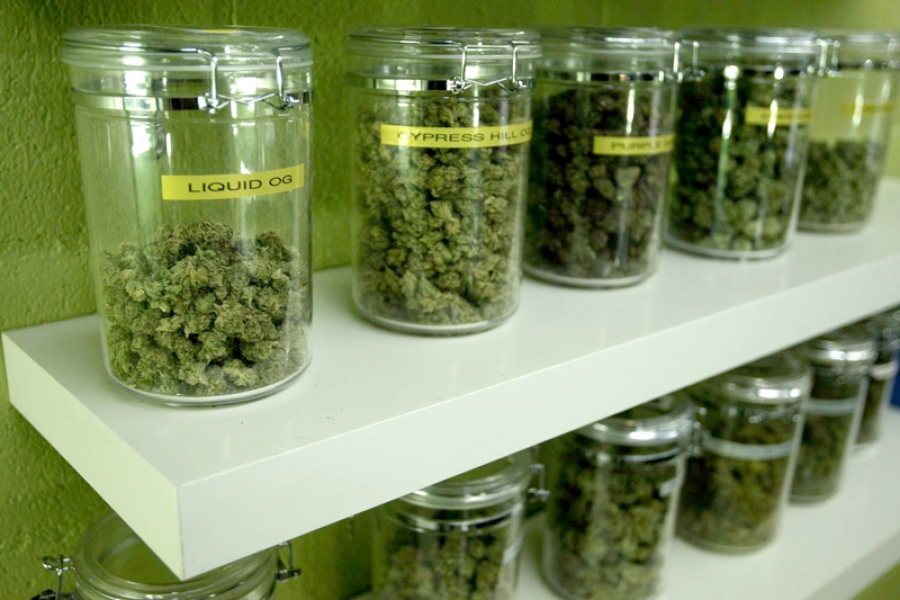Driven by concerns over marijuana marketing to teens, state lawmakers are weighing strict rules for recreational pot advertising but entrepreneurs seeking to take advantage of legal weed say that would block them from selling their products.
A voter-approved law allows adults 21 and older to possess up to an ounce of marijuana in public and up to 10 ounces at home, and to grow up to a dozen plants on their property. Retail pot shops are expected to open sometime next year.
On Beacon Hill, legislative leaders are working on a raft of regulations for pot sales and use, which they say are aimed at keeping the drug out of the hands of underage users.
“My biggest concern is that the marketing and advertising isn’t geared toward children in any way,” said Rep. Brad Hill, R-Ipswich. “The way they’ve packaged some of these things in other states, like the marijuana edibles, they look like candy bars.”
One proposal, filed by Sen. Jason Lewis, D-Winchester, would restrict marijuana advertising on public property, ban marketing designed to appeal to minors, and set strict requirements for retailers marketing their marijuana products.
Lewis, who leads a committee working on the rules, also wants marijuana advertising and marketing to display public health warnings.
Coupons, free samples, prizes, discounts or other promotional activities — including distribution of branded pot merchandise — would be prohibited.
Advertising such as signs outside a marijuana retail outlet as well as direct marketing to customers through email, texts or other forms of communication would be allowed.
Marijuana retailers also would be allowed to have websites and a social media presence under the proposal but they would have to verify that visitors to those sites are adults.
The proposal follows recommendations made last year from a legislative panel that looked at proposed regulations and called for “strict limits on marijuana marketing, advertising, and promotion in order to limit commercialization and youth appeal.”
But industry representatives say such strict rules would stunt budding businesses and drive users back to the black market.
“In every state that has legalized marijuana, you haven’t seen an increase in usage with advertising,” Chris Beals, president of Weedmaps, a California-based company, said in an interview. “These regulations are being driven by misconceptions and stigma.”
Weedmaps — which runs a dispensary-rating website for consumers and sells inventory software to retailers — describes itself as “the premiere source for all things marijuana.” It has been advertising on billboards across the state, touting the benefits of legal pot.
“States that legalized marijuana had 25 percent fewer opioid-related deaths,” reads one billboard in Revere.
Beals said the campaign is aimed at dispelling myths.
“There’s been a lot of statements by opponents and state officials that are just wrong, like this myth of marijuana being a gateway drug, its correlation to opioid abuse or increased traffic fatalities,” he said. “None of these things are based in fact.”
Billboard ads, which are generally protected as free speech, are one of the few locations in the state where marijuana advertising is now allowed.
Still, lawmakers who want to regulate pot advertising say it does not enjoy free-speech protections under the First Amendment because marijuana remains illegal under federal law.
“Thus, states and municipalities have much greater latitude to restrict marijuana advertising and marketing that they deem harmful to public health or safety,” a recent legislative report read.
Shanel Lindsay, a lawyer, marijuana advocate and entrepreneur, said marketing and advertising cannabis products is challenging in the current regulatory climate.
Broadcasters, who are licensed by the federal government, are reluctant to air pot ads because the drug is still illegal under federal law. Social media sites, online ad networks, newspapers and other print publications have partial or outright bans on advertising for marijuana businesses.
“There are very few places that will even allow you to advertise,” she said. “I’ve been rejected by Google, Facebook and others.”
He points out that outdoor advertising for beer, wine and liquor is perfectly legal.
“A ban would make marijuana seem like a quasi-legal product, which it’s not,” he said. “These are in often very expensive products where quality is important, and consumers demand real-time, accurate and trustworthy information.”
Opponents of legal weed want a complete ban on marijuana advertising.
“It’s generally hard to regulate commercial advertising, given that it’s considered free speech,” said Kevin Sabet, who leads the anti-legalization group Smart Approaches to Marijuana that opposed the ballot initiative. “We really need to have a blanket ban.”
Sabet argues that the pot industry doesn’t really need advertising to sell its products.
“People who want to get marijuana will figure out a safe place to get it,” he said.
Medical marijuana dispensaries are prohibited from advertising but many find a way around the ban by direct email and hiring third-party companies, such as Weedmaps, to market their products.
The state Department of Health, which regulates the medical marijuana industry, doesn’t have regulations on third-party service providers.
“However, there is an ongoing effort by the department to educate patients regarding online advertisement of unauthorized medical marijuana delivery services,” department spokesman Ann Scales said.
While there are no regulations specifically banning pot ads on public property, the state’s transit system has already adopted regulations prohibiting advertising.
The MBTA prohibits advertising that “promotes the sale, use or cultivation of marijuana or marijuana-related products” under rules that ban tobacco ads on the transit system’s stations, trains, buses and subway cars, according to spokesman Joe Pesaturo.
Regulations on pot advertising vary among states that have legalized the drug.
In Colorado, which legalized pot in 2012, advertising is allowed under current rules but cannot be “false or misleading” and must warn of dangers of marijuana use. It prohibits TV and radio ads, and bans ads on public property and “areas where children congregate.” It also limits advertising at sporting and charitable events.
In Washington, the advertising rules are similar but the state also prohibits giveaways, coupons for pot sales and distribution of branded merchandise.
California, which legalized marijuana this fall, is debating a ban on pot ads from state highways. The proposal follows a public backlash over billboards featuring 1970s comedian Tommy Chong promoting his favorite brand of weed.
Sabet and other opponents of pot advertising draw a parallel to the tobacco industry.
“We were lied to for 80 years by big tobacco — a multimillion-dollar industry that told us their products were safe, only for adults, not kids, and that they wouldn’t advertise,” he said. “We believed that to our peril. The question is are we going to do it again?”
credit:420intel.com













